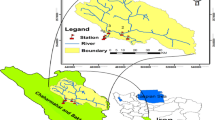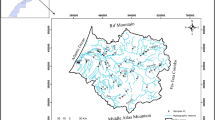Abstract
The Kashkan River (KR), located in the west of Iran, is a major source of water supply for residential and agricultural areas as well as livestock. The objective of this study was to assess the spatial and long temporal variations of surface water quality of the KR based on measured chemical ions. The Canadian Council of Ministers of Environment Water Quality Index (CCME WQI) technique was utilized using measurements from 10 sampling stations during a period of 36 years (1974–2009). The measured data included cations (Na+, K+, Ca2+, Mg2+), anions (HCO3 −, Cl−, SO4 2−), pH, and electrical conductivity. Principal component analysis was performed to identify which of the parameters to be included in the CCME WQI calculations were actually correlated and which ones were responsible for most of the variance observed in the water-quality data. In addition, KR water quality was evaluated for its suitability for drinking and irrigation purposes using conventional methods. Last, trend detection in the WQI time series of the KR showed water-quality degradation at all sampling stations, whereas the Jelhool sub-basin more adversely affects the quality of KR water in the watershed. Nonetheless, on average, the water quality of the KR was rated as fair.








Similar content being viewed by others

References
American Public Health Association (1985) Standard methods of water and waste water analysis, 13th edn. APHA, Washington
American Public Health Association (1995) Standard methods for the examination of water and wastewater, 19th edn. APHA, Washington, DC
American Public Health Association, American Water Works Association, Water Pollution Control Federation (1971) Standard methods for the examination of water and wastewater. APHA, Washington
Aris AZ, Praveena SM, Abdullah MH, Radojevic M (2012) Statistical approaches and hydrochemical modelling of groundwater system in small tropical island. J Hydroinform 14(1):206–220
Awadallah AG, Fahmy H, Karaman HG (2010) Trend detection in water quality data using time series seasonal adjustment and statistical tests. Irrigation Drain 60(2):253–262
Ayers RS, Wescot DW (1985) Water quality for irrigation. FAO Irrigation and Drainage Paper No. 20, Revision 1. FAO, Rome, Italy
Babaei SF, Hassani AH, Torabian A, Karbassi AR, Hosseinzadeh LF (2011) Evolution of a new surface water quality index for Karoon catchment in Iran. Water Sci Technol 64(12):2483–2491
Canadian Council of Ministers of Environment (2001) Canadian water quality guidelines for the protection of aquatic life: CCME Water Quality Index 1.0, Technical Report. In: Canadian Environmental Quality Guidelines (2001) Canadian Council of Ministers of the Environment. Winnipeg, Canada
Chang H (2008) Spatial analysis of water quality trends in the Han River basin, South Korea. Water Res 42:3285–3304
Chen Z, Ivanov PC, Hu K, Stanley HE (2002) Effect of nonstationarities on detrended fluctuation analysis. Phys Rev E Stat Nonlin Soft Matter Phys 65(4 Pt 1):041107
Cieszynska M, Wesolowski M, Bartoszewicz M, Michalska M, Nowacki J (2012) Application of physicochemical data for water-quality assessment of watercourses in the Gdansk municipality (South Baltic coast). Environ Monit Assess 184:2017–2029
Cude CG (2001) Oregon water quality index: a tool for evaluating water quality management effectiveness. J Am Water Resour Assoc 37(1):125–137
Domenico PA, Schwartz FW (1990) Physical and chemical hydrogeology. Wiley, New York
Handa BK (1969) Description and classification of media for hydro-geochemical investigations. In: Symposium on ground water studies in arid and semiarid regions. Roorkee, India
Hem JD (1985) Study and interpretation of the chemical characteristics of natural water. United States Geological Survey Water Supply 2254
Hirsch RM, Alexander RB, Smith R (1991) Selection of methods for the detection and estimation of trends in water quality. Water Resour Res 27(5):803–813
Kantelhardt JW, Zschiegner S, Koscielny-Bunde E, Havlin S, Bunde A, Stanley HE (2002) Multifractal detrended fluctuation analysis of nonstationary time series. Physica A Stat Mech Appl 316:87–114
Karamouz M, Zahraie B, Kerachian R, Mahjouri N, Moridi A (2006) Development of a master plan for industrial solid waste management. Int J Environ Sci Technol 3(3):229–242
Kendall MG (1975) Rank correlation methods. Griffin, London
Keshtkar AR, Mahdavi M, Salajegheh A, Ahmadi H, Sadoddi A, Ghermezcheshmeh B (2011) Exploring the relationship between land use and surface water quality using multivariate statistics in arid and semi-arid regions. Desert 16:33–38
Khan F, Husain T, Lumb A (2003) Water quality evaluation and trend analysis in selected watersheds of the Atlantic region of Canada. Environ Monit Assess 88:221–242
Li Z, Zhang YK (2007) Quantifying fractal dynamics of groundwater systems with detrended fluctuation analysis. J Hydrol 336:139–146
Liou SM, Lo SL, Wanga SH (2004) Generalized water quality index for Taiwan. Environ Monit Assess 96:35–52
Lumb A, Halliwell D, Sharma T (2006) Application of CCME WQI quality index to monitor water quality; a case study of the Mackenzie River basin, Canada. Environ Monit Assess 113:411–429
Mann HB (1945) Nonparametric tests against trend. Econometrica 13:245–259
Matsoukas C, Islam S, Rodriguez-Iturbe I (2000) Detrended fluctuation analysis of rainfall and streamflow time series. J Geophys Res 105:29165–29172
Meng XL (1994) Multiple imputation with uncongenial sources of input. Stat Sci 9(4):538–573
Noori R, Karbassi A, Khakpour A, Shahbazbegian M, Mohammadi KBH, Vesali-Naseh M (2011) Chemometric analysis of surface water quality data: case study of the Gorganrud River Basin, Iran. Environ Model Assess 17(4):411–420
Ott WR (1978) Environmental indices: theory and practice. Ann Arbor Science Publishers, Ann Arbor, MI
Pejman AH, Bidhendi NGR, Karbassi AR, Mehrdadi N, Bidhendi EM (2009) Evaluation of spatial and seasonal variations in surface water quality using multivariate statistical techniques. Int J Environ Sci Technol 6(3):467–476
Peng CK, Havlin S, Stanley HE, Goldberger AL (1995) Quantification of scaling exponents and crossover phenomena in nonstationary heartbeat time series. Chaos 5(1):82–87
Piper AM (1944) A graphic procedure in the geochemical interpretation of water-analyses. Trans Am Geophys Union 25:914–928
Qadir A, Naseem R, Malik RF, Husain SZ (2008) Spatio-temporal variations in water quality of Nullah Aik tributary of the River Chenab, Pakistan. Environ Monit Assess 140:43–59
Richards LA (1954) Diagnosis and improvement of saline and alkaline soils. United States Salinity Laboratory, Department of Agriculture Hand Book, Washington
Rosemond SD, Duro DC, Dube M (2009) Comparative analysis of regional water quality in Canada using the water quality index. Environ Monit Assess 156:223–240
Salas JD (1993) Analysis and modeling of hydrologic time series. In: Maidment DR (ed) Handbook of hydrology. McGraw-Hill, New York
Sargaonkar A, Gupta A, Devotta S (2008) Dynamic weighting system for water quality index. Water Sci Technol 58(6):1261–1271
Sedeno-Diaz JE, Lopez-Lopez E (2006) Water quality in the Río Lerma, Mexico: an overview of the last quarter of the twentieth century. Water Resour Manag 9(3):379–385
Sharma A, Singh AK, Kumar K (2010) Environmental geochemistry and quality assessment of surface and subsurface water of Mahi River basin, western India. Environ Earth Sci 65:1231–1250
Shuval HI, Adin A, Fiatal B, Raawitz E, Yekuterl P (1986) Wastewater irrigation in developing countries. Health effects and technological solutions. World Bank Technical Paper No. 52. World Bank, Washington
Singh AK, Mondal GC, Kumar S, Singh TB, Tewary BK, Sinha A (2008) Major ion chemistry, weathering processes and water quality assessment in upper catchment of Damodar River basin, India. Environ Geol 54:745–758
Sojka M, Siepak M, Zioła A, Frankowski M, Błażejewska SM, Siepak J (2008) Application of multivariate statistical techniques to evaluation of water quality in the Mała Wełna River (Western Poland). Environ Monit Assess 147:159–170
Sorinejad A (2002) Estimation the runoff of KR by using GIS [in Persian]. Geogr Res Q 34(43):57–80
Stambuk-Giljanovic N (2003) The water quality of the Vrgorska Matica River. Environ Monit Assess 83:229–253
Szabolcs I, Darab C (1964) The influence of irrigation water of high sodium carbonate content of soils. Proceeedings of the 8th International congress of ISS Trans. Vol 2, pp 803–812
Talkner P, Weber RO (2000) Power spectrum and detrended fluctuation analysis: application to daily temperatures. Phys Rev E Stat Phys Plasmas Fluids Relat Interdiscip Topics 62:150–160
Todd DK, Mays LW (2005) Groundwater hydrology, 3rd edn. Wiley, New York, p 636
Water Resource Management Company (2010) River bank data: data of physicochemical quality of surface water. WRMC, Tehran
World Health Organization (1993) Guidelines for drinking water quality. Vol 1. 2nd ed. Recommendations. WHO, Geneva
Yue S, Wang C (2004) The Mann–Kendall test modified by effective sample size to detect trend in serially correlated hydrological series. Water Resour Manag 18:201–218
Yue J, Zhao X, Shang P (2010) Effect of trends on detrended fluctuation analysis of precipitation series. Math Probl Eng. doi:10.1155/2010/749894
Zaporozec A (1972) Graphical interpretation of water-quality data. Ground Water 10(2):32–43
Zhou F, Liu Y, Guo H (2007) Application of multivariate statistical methods to water quality assessment of the watercourses in Northwestern New Territories, Hong Kong. Environ Monit Assess 132:1–13
Acknowledgments
This study was funded by the Soil Conservation and Watershed Management Research Institute (SCWMRI). The author thanks the anonymous reviewers for their insightful comments, which were very useful in improving the manuscript. The writer is also thankful to the members of the Iranian WRMC for providing data.
Author information
Authors and Affiliations
Corresponding author
Rights and permissions
About this article
Cite this article
Mostafaei, A. Application of Multivariate Statistical Methods and Water-Quality Index to Evaluation of Water Quality in the Kashkan River. Environmental Management 53, 865–881 (2014). https://doi.org/10.1007/s00267-014-0238-6
Received:
Accepted:
Published:
Issue Date:
DOI: https://doi.org/10.1007/s00267-014-0238-6



